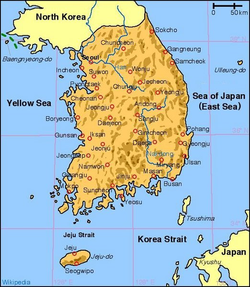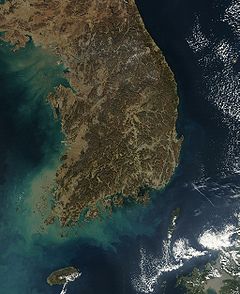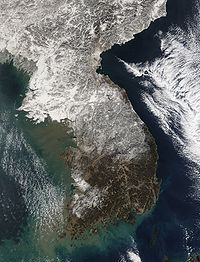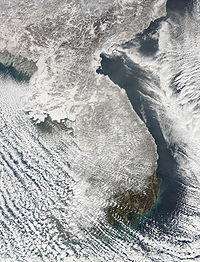- Geography of South Korea
-
Coordinates: 36°30′N 127°30′E / 36.50°N 127.5°E
South Korea is located in East Asia, on the southern half of the Korean Peninsula jutting out from the far east of the Asian land mass. The only country with a land border to South Korea is North Korea, lying to the north with 238 kilometres (148 mi) of border running along the DMZ. South Korea is mostly surrounded by water and has 2,413 kilometres (1,499 mi) of coast line along three seas. To the west is the Yellow Sea, to the south is the East China Sea, and to the east is Ulleung-do and Liancourt Rocks in the Sea of Japan (East Sea). Geographically, South Korea's land mass is approximately 100,032 square kilometres (38,623 sq mi).[1] 290 square kilometres (110 sq mi) of South Korea are occupied by water. The approximate coordinates are 37° North, 127° 30 East.
Contents
Land area and borders
The Korean Peninsula extends southward from the northeast part of the Asian continental landmass. The Japanese islands of Honshū and Kyūshū are located some 200 kilometers to the southeast across the Korea Strait; the Shandong Peninsula of China lies 190 kilometers to the west. The west coast of the peninsula is bordered by the Korea Bay to the north and the Yellow Sea and Korea Strait to the south; the east coast is bordered by the Sea of Japan. The 8,640-kilometer coastline is highly indented. Some 3,579 islands lie adjacent to the peninsula. Most of them are found along the south and west coasts.
The line between the two Korean states was the thirty-eighth parallel of latitude. After the Korean War, the Korean Demilitarized Zone (DMZ) formed the boundary between the two. The DMZ is a heavily guarded, 4,000-meter-wide strip of land that runs along the Demarcation line established by the s:Korean Armistice Agreement, from the east to the west coasts for a distance of 241 kilometers (238 kilometers of that line form the land boundary with North Korea).
The total land area of the peninsula, including the islands, is 223,170 square kilometers. Some 44.6 percent (98,477 square kilometers) of this total, excluding the area within the DMZ, constitutes the territory of the Republic of Korea. The combined territories of North Korea and South Korea are about the same size as the state of Minnesota. South Korea alone is about the size of Portugal or Hungary.
The largest island, Jeju-do, lies off the southwest corner of the peninsula and has a land area of 1,825 square kilometers. Other important islands include Ulleung and Liancourt Rocks in Sea of Japan and Ganghwa Island at the mouth of the Han River. Although the eastern coastline of South Korea is generally unindented, the southern and western coasts are jagged and irregular. The difference is caused by the fact that the eastern coast is gradually rising, while the southern and western coasts are subsiding.
Topography and drainage
Early European visitors to Korea remarked that the land resembled "a sea in a heavy gale" because of the large number of successive mountain ranges that crisscross the peninsula. The tallest mountains are in North Korea. The tallest mountain in South Korea is Hallasan (1,950 m), which is the cone of a volcanic formation constituting Jeju Island. There are three major mountain ranges within South Korea: the Taebaek Mountains, and Sobaek ranges, and the Jiri Massif.
Unlike Japan or the northern provinces of China, the Korean Peninsula is geologically stable. There are no active volcanoes and there have been no strong earthquakes. Historical records, however, describe volcanic activity on Mount Halla during the Goryeo Dynasty (918–1392).
Over the centuries, Korea's inhabitants have cut down most of the ancient Korean forests, with the exception of a few remote, mountainous areas. The disappearance of the forests has been a major cause of soil erosion and flooding. Because of successful reforestation programs and the declining use of firewood as a source of energy since the 1960s, most of South Korea's hills in the 1980s were amply covered with foliage. South Korea has no extensive plains; its lowlands are the product of mountain erosion. Approximately 30 percent of the area of South Korea consists of lowlands, with the rest consisting of uplands and mountains. The great majority of the lowland area lies along the coasts, particularly the west coast, and along the major rivers. The most important lowlands are the Han River plain around Seoul, the Pyeongtaek coastal plain southwest of Seoul, the Geum River basin, the Nakdong River basin, and the Yeongsan and the Honam plains in the southwest. A narrow littoral plain extends along the east coast.
The Nakdong is South Korea's longest river (521 kilometers). The Han River, which flows through Seoul, is 514 kilometers long, and the Geum River is 401 kilometers long. Other major rivers include the Imjin, which flows through both North Korea and South Korea and forms an estuary with the Han River; the Bukhan, a tributary of the Han that also flows out of North Korea; and the Somjin. The major rivers flow north to south or east to west and empty into the Yellow Sea or the Korea Strait. They tend to be broad and shallow and to have wide seasonal variations in water flow.
News that North Korea was constructing a huge multipurpose dam at the base of Geumgangsan (1,638 m) north of the DMZ caused considerable consternation in South Korea during the mid-1980s. South Korean authorities feared that once completed, a sudden release of the dam's waters into the Pukhan River during north-south hostilities could flood Seoul and paralyze the capital region. During 1987 the Geumgangsan Dam was a major issue that Seoul sought to raise in talks with Pyongyang. Though Seoul completed a "Peace Dam" on the Pukhan River to counteract the potential threat of Pyongyang's dam project before the 1988 Olympics, the North Korean project apparently still was in its initial stages of construction in 1990.
Maritime claims:
contiguous zone: 24 nmi (44.4 km; 27.6 mi)
continental shelf: not specified
exclusive economic zone: 200 nmi (370.4 km; 230.2 mi)
territorial sea: 12 nmi (22.2 km; 13.8 mi); between 3 nmi (5.6 km; 3.5 mi) and 12 nmi (22.2 km; 13.8 mi) in the Korea StraitElevation extremes:
lowest point: Sea level 0 m
highest point: Hallasan 1,950 mClimate
Part of the East Asian monsoonal region, South Korea has a temperate climate with four distinct seasons. The movement of air masses from the Asian continent exerts greater influence on South Korea's weather than does air movement from the Pacific Ocean. Winters are usually long, cold, and dry, whereas summers are short, hot, and humid. Spring and autumn are pleasant but short in duration. Seoul's mean temperature in January is −5 to −2.5 °C (23 to 28 °F); in July the mean temperature is about 22.5 to 25 °C (73 to 77 °F). Because of its southern and seagirt location, Jeju Island has warmer and milder weather than other parts of South Korea. Mean temperatures on Jeju range from 2.5 °C (36.5 °F) in January to 25 °C (77 °F) in July.
The country generally has sufficient rainfall to sustain its agriculture. Rarely does less than 750 millimeters (29.5 in) of rain fall in any given year; for the most part, rainfall is over 1,000 millimeters (39.4 in). Amounts of precipitation, however, can vary from year to year. Serious droughts occur about once every eight years, especially in the rice-producing southwestern part of the country. About two-thirds of the annual precipitation occurs between June and September.
South Korea is less vulnerable to typhoons than Japan, Taiwan, the east coast of China, or the Philippines. From one to three typhoons can be expected per year. Typhoons usually pass over South Korea in late summer, especially in August, and bring torrential rains. Flooding occasionally causes considerable damage. In September 1984, record floods caused the deaths of 190 people and left 200,000 homeless. This disaster prompted the North Korean government to make an unprecedented offer of humanitarian aid in the form of rice, medicine, clothes, and building materials. South Korea accepted these items and distributed them to flood victims.
Resources and land use
Natural resources: South Korea produces coal, tungsten, graphite, molybdenum, lead, and has potential for hydropower.
Land use:
arable land: 19%
permanent crops: 2%
permanent pastures: 1%
forests and woodland: 65%
other: 13%
rivers and lakes: 10% (2003 est.) Irrigated land: 13,350 km² (1993 est.)Environmental concerns
Natural hazards: There are occasional typhoons that bring high winds and floods. There is also low-level seismic activity, which is common in the southwest.
Environment - current issues: Habitat loss and degradation, especially of wetlands, through coastal reclamation (e.g. Saemangeum, Shiwa, Song Do, Namyang Bay, Asan Bay, in the south-west, Gwangyang Bay and the Nakdong Estuary) have caused huge declines in fisheries and of biodiversity. Most riverine wetland in Korea is now threatened by the proposed Grand Korean Waterway project. There are also some problems air pollution in large cities; as well as water pollution from the discharge of sewage and industrial effluents. Drift net fishing is another issue.
Environment - international agreements:
party to: Antarctic-Environmental Protocol, Antarctic Treaty, Biodiversity, Climate Change, Desertification, Endangered Species, Environmental Modification, Hazardous Wastes, Law of the Sea, Marine Dumping, Nuclear Test Ban, Ozone Layer Protection, Ship Pollution (MARPOL 73/78), Tropical Timber 83, Tropical Timber 94, Wetlands, Whaling
signed, but not ratified: Climate Change Kyoto ProtocolReferences
 This article incorporates public domain material from websites or documents of the CIA World Factbook.
This article incorporates public domain material from websites or documents of the CIA World Factbook.
See also
- List of Korea-related topics
- Geography of North Korea
- National parks of South Korea
- List of islands of Korea
- List of lakes in Korea
- List of rivers of Korea
- List of mountains in Korea
Geography of Asia Sovereign
statesAfghanistan · Armenia · Azerbaijan · Bahrain · Bangladesh · Bhutan · Brunei · Burma (Myanmar) · Cambodia · People's Republic of China · Cyprus · East Timor (Timor-Leste) · Egypt · Georgia · India · Indonesia · Iran · Iraq · Israel · Japan · Jordan · Kazakhstan · North Korea · South Korea · Kuwait · Kyrgyzstan · Laos · Lebanon · Malaysia · Maldives · Mongolia · Nepal · Oman · Pakistan · Philippines · Qatar · Russia · Saudi Arabia · Singapore · Sri Lanka · Syria · Tajikistan · Thailand · Turkey · Turkmenistan · United Arab Emirates · Uzbekistan · Vietnam · Yemen
States with limited
recognitionAbkhazia · Nagorno-Karabakh · Northern Cyprus · Palestine · Republic of China (Taiwan) · South Ossetia
Dependencies and
other territoriesClimate of Asia Sovereign
statesAfghanistan · Armenia · Azerbaijan · Bahrain · Bangladesh · Bhutan · Brunei · Burma (Myanmar) · Cambodia · People's Republic of China · Cyprus · East Timor (Timor-Leste) · Egypt · Georgia · India · Indonesia · Iran · Iraq · Israel · Japan · Jordan · Kazakhstan · North Korea · South Korea · Kuwait · Kyrgyzstan · Laos · Lebanon · Malaysia · Maldives · Mongolia · Nepal · Oman · Pakistan · Philippines · Qatar · Russia · Saudi Arabia · Singapore · Sri Lanka · Syria · Tajikistan · Thailand · Turkey · Turkmenistan · United Arab Emirates · Uzbekistan · Vietnam · Yemen
States with limited
recognitionAbkhazia · Nagorno-Karabakh · Northern Cyprus · Palestine · Republic of China (Taiwan) · South Ossetia
Dependencies and
other territoriesChristmas Island · Cocos (Keeling) Islands · Hong Kong · Macau
Categories:
Wikimedia Foundation. 2010.





